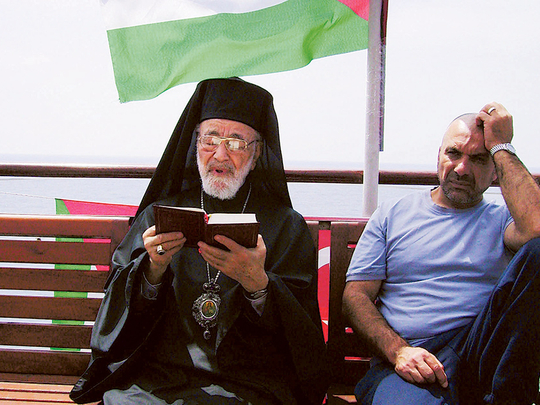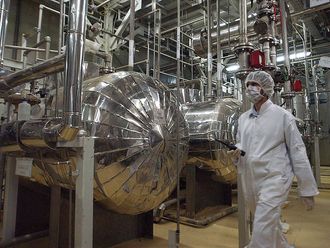
Beirut: Hilarion Capucci, the celebrated former archbishop of Jerusalem, died in Rome on January 1, 2017 at the age of 94, as announced by the Vatican in an official statement. He was mourned both by the Hamas government in Gaza and by Palestinian President Mahmoud Abbas who described him as a “martyr of Jerusalem”. The Melkite Greek Catholic Patriarch of Antioch and All the East Gregarious III Laham also paid homage to Capucci, describing him as a “hero” of the Palestinian cause.
Capucci was born in the ancient city of Aleppo during the years of French colonial rule in March 1922, once the industrial capital of Syria now reduced to rubble by the six-year war. Capucci was ordained a Catholic priest of the Basilian Alepian Order in the summer of 1947, and nine years later he became archbishop and in 1965, Patriarchal Vicar of Jerusalem.
During the 1960s, Capucci became something of a public intellectual and unappointed ambassador for the Palestinian cause, writing, preaching, and lecturing about justice for the Palestinians and Israel’s atrocities and human rights abuses. “Jesus Christ was the first Fedayeen [resistance fighter]. I am just following his example” he said.
When the Palestinian revolution was declared on January 1, 1965, Capucci immediately came out in its defence, striking a friendship with Yasser Arafat that was to last a lifetime.
“He had an excellent relationship with Abu Ammar,” recalled the former Palestinian First Lady Suha Arafat, a Christian convert to Islam, adding that Arafat had “deep admiration” for Capucci and would often take him along to international conventions along with the Mufti of Jerusalem, to stress a united Muslim-Christian stance against the Israeli occupation.
Speaking to Gulf News, she added: “His cross was also his sword — he never carried a weapon in his life. He was a great man and lived by his convictions despite the tremendous amount of psychological and physical pressure that he was subjected to by the Israelis. President Arafat loved him dearly and so did I, ever since I first met him in Nablus when I was a child.”
On August 8, 1974, the Syrian-born priest was arrested by Israeli police for smuggling weapons to the West Bank in a Mercedes Benz. He was caught in the possession of grenades, rifles, and over two hundred pounds of explosives that he was planning to deliver to the Palestinian Liberation Organisation (PLO). He was brought to trial in occupied Jerusalem, ironically on Salah Al Din Al Ayyubi Street, named after the Muslim Sultan who fought the Crusaders in Jerusalem, and the courtroom was attended by prominent international lawyers who came to his defence. Loudspeakers were installed and thousands lined up to follow his fate — having become an iconic symbol of resistance for the Palestinians. He was convicted of using his clerical and diplomatic standing to support “terrorism” and he was sent to 12 years behind bars at the Ramle Prison, an Israeli-held city in central Palestine at the intersection connecting the port of Jaffa with Jerusalem.
Maximos V, the patriarch of the Melkite Church, came out in his defence, saying: “If we go back in history we find other bishops who smuggled weapons, gave their lives and committed other illegal actions to save Jews from Nazi occupation. I do not see why a man who is ready to save Arabs should be condemned.”
In response, various Palestinian groups launched a series of attacks against Israel, the first being on the northern Israeli village of Kfar Yuval, taking hostages in June 1975 and refusing to release them until Capucci was set free. Then-Israeli Prime Minister Yitzhak Rabin refused to comply, however, and other attacks quickly followed, notably on June 27, 1976 when Palestinian commandos from the Popular Front for the Liberation of Palestine (PFLP) hijacked an Air France Flight 139 headed from Tel Aviv to Paris, with its 248 passengers. They were flown to Entebbe, near Kampala, the capital of Uganda. They were welcomed by Ugandan President Idi Amin, who demanded the release of Palestinian prisoners in Israeli jails, namely Hilarion Capucci. Their mission was foiled with a counter-operation launched by Israeli forces.
“During the trial and period of his arrest, he was subjugated to unbearable torture as well as a systematic campaign of character slaughter in the Israeli press,” recalls Raymonda Al Tawil, a prominent Palestinian poet and journalist who attended the trial, adding: “He reminded us of Fares Al Khoury, the celebrated Syrian Christian nationalist who fought the Ottomans and the French and became prime minister and speaker of parliament of his country in the 1940s.”
On November 7, 1977, The Washington Post reported: “Demands for Capucci’s release have turned up regularly in the lists submitted by airplane hijackers, including the Entebbe hijackers, but where the threats have failed, a personal letter from Pope [John] Paul has apparently succeeded. The appeal is being made on humanitarian grounds.”
Capucci was released after spending just two years in jail on November 7, 1977 and Israeli conditioned that he be banished from Palestine and cease all political activity. He took up residence in Rome then — becoming more active and famous than ever before — and in January 1979, attended the meetings of the PLO National Council in Damascus. He then served as the Vatican’s contact with the PLO’s foreign minister, Farouk Al Qaddumi. He was welcomed with red carpets in Baghdad and Damascus, becoming a close associate of President Hafez Al Assad, and was honoured by the governments of Iraq, Libya, Egypt, and Sudan.
During the hostage crisis at the American embassy in Tehran, after the Islamic Revolution of 1979, Capucci played a leading role as mediator where he met the hostages and secured the release of the dead American soldiers who had been killed in the rescue mission. Capucci also negotiated an agreement for the release of the hostages, but the plan collapsed because the French press published the story before the agreement had been approved by Iran’s new Majlis.
In 2000-2003 he emerged as an outspoken critic of the war on Iraq and an active advocate of the second Palestinian uprising (intifada) that erupted in Jerusalem in September 2000. In 2009, Capucci boarded a Lebanese ship bound for Gaza, which was seized by Israeli forces when it attempted to violate Israel’s naval blockade. In May 2010 Capucci participated in the Free Gaza Movement’s Freedom Flotilla to the Gaza Strip. He was a passenger on the Turkish MV Mavi Marmara, which was seized in the early hours of May 31 by the Israeli navy. Nine people were killed and many were injured. At 88, Capucci was arrested for the second time, and held at Beersheba prison, and then deported amidst international outcry.
Regretfully, Raymonda Al Tawil adds: “In his farewell, we can only say that he was a strong man, determined and immutable, just like the Citadel of Aleppo that he so loved.”
Fadi Esber, the editor of the peer-reviewed historical journal Dimashq, added to Gulf News: “The life and works of Hilarion Capucci, his commitment to Palestine above all, for which he paid a heavy price, are a testament to how Arab Christians have always identified themselves with their Arab homeland. Today, as many Christians are forced into exile, leaving their homes in Iraq, Syria, and Palestine, Capucci’s life offers a valuable lesson to all, for although circumstances may force many to leave their homeland, distance will never transform into forgetfulness.”












